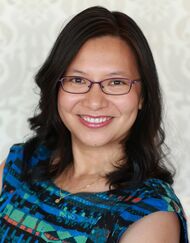|
8/18/2023 0 Comments Life as a rockstar engineer: an interview with Emily Talbott, Controls IntegratorBy Robbin Koenig You may not recognize the name, but Emily Talbott, Controls Integrator for TAIT, is the unseen rock star in automation technology. She creates the “awe factor” for audiences at Bad Bunny, Billie Eilish, and Phish concerts, as well as Broadway and theater productions and theme park installations. In collaboration with her team, Emily is responsible for crafting a musical experience into an audio and visual multisensory phenomenon. She has been able to amalgamate her education, training, and work experiences into an exciting and formidable career.
She kindly answered the following questions posed by Scientista.
0 Comments
by Deanna Ratnikova, American Physical Society
Edited by Lauren Koenig (an earlier version of this article was originally published on 12/10/2012) By Jasmine Dyoco Edited by Lauren Koenig Though women were instrumental to the growth and development of STEM fields, data shows that the number of women entering these industries has flattened. If you’re looking to break barriers to realize the career of your dreams, here are some suggestions for how to overcome the challenges that women face in STEM. Photo by Unsplash
10/19/2022 0 Comments So You Want to Be a Data Scientist?Author: Celine Nugroho Editor: Kendra Loedige In 2001, the term “data science” was used for the first time to define a new combination of statistical and computer sciences. Ever since then, the emerging field has seen a dramatic increase in interest. Virtually every industry nowadays is clamouring for a data scientist: data scientists enable companies to make better business decisions by extracting actionable insights from data. Despite the high demand, the percentage of female data scientists remains very low. A 2021 Harnham report divulges that only 27% of US data and analytics professionals are women. This number is bound to be lower in developing countries, where women often get limited to no access to STEM-based education – a crucial foundation for those looking to pursue data science. But what is it really like as a woman in data science? Nadya Asanul Husna and Labibah Alya, data scientists associated with Data Science Indonesia, provide insight into the inner workings of a data-driven STEM career. Photo of Nadya (Credit: Nadya Asanul Husna)
By Kayleigh Alexandra Image: Pexels When you first start out on a career path, you're full of enthusiasm and motivation. But things can change over time, and it's not uncommon to start feeling frustrated or disengaged with your work and your career. If you think you've fallen out of love with your career, take a look at these tips to help you make your next move.
10/25/2020 1 Comment Many women still drop out of science careers. Why is this happening and how do we fix it?By Lauren Koenig The glass ceiling is well-known for preventing women and minorities from reaching the highest levels of the business world. Women in science face a similar problem: the leaky pipeline. This metaphor is used to describe how women drop out of the sciences at many points along their career path, leading to few women attaining top professional roles.
Fixing the pipeline is a more complex problem than it seems at first glance. The “leaks” are distributed at different stages of a woman’s career and across different disciplines. Nearly half of all biologists today are women, but chemistry (32%) and physics (18%) continue to lag far behind. How does biology excel where other disciplines fail? Can we use that information to help women pursue their professional goals? Here, we review ongoing challenges, recommendations and our predictions for the state of women in science. By Joanna Lee If you ask my colleagues, I’m hilarious. My award-winning joke this week was, “Keeping my eyes on the cloud, just like Elon Musk,” while I point at a cloud of brine shrimp. Given that research suggests a good sense of humor is linked to higher social status, sexual success, and intelligence, one might expect me to be an incredibly popular genius. However, according to a new study, this might not be the case for everyone.
7/2/2019 0 Comments What Is the ‘Gender Pain Gap’?By Karlyn Q. It’s 2019 and women have been handed another hurdle to jump over when it comes to their healthcare. Lawmakers continue to work to abolish access to federal and state-funded reproductive health services all while inhibiting safe abortion care. But this is just one of the many barriers to quality healthcare that women continue to face. Unconscious gender bias, which refers to a subconscious assessment based on gender that influences one's actions and feelings, remains a major obstacle to women’s healthcare, but only until recently have certain health inequalities, like The Gender Pain Gap, become a part of the conversation. Too often, women experience patient dismissal and misdiagnoses due to gender disparities in pain treatment. This piece serves as an overview of what precisely the Gender Pain Gap is, the negative impact it has on women obtaining the best possible health outcomes, and how to overcome this phenomenon. The Gender Pain Gap Defined
The Gender Pain Gap refers to the bias against women as it pertains to the treatment of pain, which stems from a landmark study performed at Maryland University called “The Girl Who Cried Pain.” Researchers found that women often experience dismissal of their medical concerns, leading to misdiagnosis, incorrect medicine dosages, delayed treatment, and general feelings of neglect. The exact reason for how the Gender Pain Gap came to be is challenging to pin down, but various studies allude to sexism, a lack of medical research on women, and gender-related differences in the experiences of pain. Causes Of The Gender Pain Gap Sexism significantly affects women’s ability to receive appropriate care for pain in many facets. Not only do healthcare providers take longer to address women’s pain, but they are also more likely to misdiagnose women’s pain as psychogenic or emotional. Consequently, women are more likely to be given sedatives instead of pain-relieving drugs which can lead to a delay in accurate diagnosis and proper treatment. Furthering the gender divide in healthcare is the lack of knowledge surrounding women and the pain they experience, which could possibly stem from the exclusion of women in medical research. Approximately 70% of those who suffer from chronic pain are women and yet 80% of pain studies are conducted using male mice or human men. In fact, a Caucasian male weighing 154 pounds standing at 5 feet and 6 inches tall has long been the standard body type for studying human anatomy and drawing medical test conclusions. However, hormones, as well as brain function, play a significant role in how women’s experiences with pain differ from men’s, thus indicating that the standard male body is no longer a suitable universal standard for research and more women and female animal models need to be included in these types of studies. Impacts And Significance Of The Gender Pain Gap The result of gender biases in our medical system can have severe and sometimes fatal repercussions. For instance, women are 50% more likely to receive the wrong diagnosis after a heart attack compared to men, leading to an increased risk of death. The very thought seems inconceivable considering heart disease is the leading cause of death for women in the U.S. Heart attacks are just one example of diagnostic errors in women. On average, it takes approximately nine years and four doctors for women to receive a correct endometriosis diagnosis – a notably painful condition where tissue that typically lines the inside of the uterus grows outside of the uterus. Endometriosis symptoms are not visible, so women who are suffering, once again, have their pain dismissed and are not appropriately treated. In cases where women are given a correct endometriosis diagnosis, they often postpone seeking help because “they themselves viewed their agonizing period pain as normal,” according to a discussion with Vice and Abby Norman, author of Ask Me About My Uterus. Like any other condition, an incorrect diagnosis can lead to delayed treatment and a negative impact on a woman’s quality of life. Overturning The Gender Pain Gap In 2015, the National Institutes of Health made a step toward healthcare equality by introducing a policy that requires medical investigators to account for sex as a biological variable during research. Even with this small step, there is still a real need for increased education and awareness surrounding biological differences in pain, as well as a need for more guidance for women whose pain isn’t being taken seriously. Women who continue to endure medical dismissal and misdiagnoses may learn to take on an active role in their own disease management. By learning how to advocate for themselves, empowered patients trust their body and use their instincts to make informed decisions about their healthcare. This could look like coming to appointments with a list of questions, asking for clarification when needed or opting to find a second opinion. It can also mean becoming a smart healthcare consumer by utilizing new and upcoming technological services in the healthcare space such as telemedicine. Telemedicine can offer clinical services without an in-person visit and has many benefits such as reducing administrative mistakes and allowing patients access to care on their own terms. Companies like hers, a telemedicine company focusing on women's health needs, was created due to the fact that women don't receive the same attention in the healthcare system as men. By providing women with direct, immediate access to trusted physicians and prescription solutions for sexual wellness, skin care, and hair loss, hers is “putting the power back in the hands of women” in a broken healthcare system, as told by co-founder and brand team lead, Hilary Coles. To learn more about their mission to create a more inclusive healthcare space for women, check out hers’ Twitter account as they use their platforms to increase awareness around women’s healthcare issues and provide valuable information and resources. By Robbin Koenig Juliet Chin Hart, Founder, Hart & Chin Associates, LLC Juliet Chin Hart was a panelist for the Alternate Careers workshop at the 2019 Scientista Symposium. She was a researcher in biopsychology and then transitioned to working for assorted biotech and big pharma organizations. Applying her knowledge of science-based industries, as well as strategic business management, Hart founded Hart & Chin Associates, LLC, a niche consulting firm, that also offers workshops and coaching for organizations involved in various scientific disciplines. The mission is to cultivate scientists’ leadership skills, interpersonal skills, and communication. Hart fills in the gaps not covered in graduate school programs that enable scientists to become effective leaders at their institutions and in their scientific specialization. In the following question and answer interchange, Juliet Chin Hart explains her rationale for developing methods to improve management styles and science personnel satisfaction. Q: What motivated you to start the company and what were the challenges? A: After working in academia, biotech, and pharma with other scientists, I realized there was a need for more professional development resources that resonated with the scientist and is relevant in their work environments. So, I decided to start a company focused specifically on scientists and their organizations. It is a specialized area of work, so getting awareness about what I do is the hardest part. Q: What niche do you think it will fill? A: My intention is to help scientists at all stages of their careers. Right now, training for scientists typically is focused on developing the technical knowledge and skills specifically needed for their field. Adding essential basics, such as interpersonal and communication skills training with examples from the scientists’ worlds, will make it easier for them to adapt and transition in their careers. Q: Are there any soft skills that you address that are unique to the scientific community? A: Everyone needs soft skills, but leadership and management training are important for scientists to be successful in any aspect of their career growth to increase their influence in whatever role they are in or striving to attain. On top of that, cultural adaptability training is very important. We tend to ignore the fact that scientists work in very culturally diverse environments and it can be difficult, but at the same time very rewarding. The training allows us to understand ourselves and others better so that we can maximize our potential. Q: What are the most popular workshops? How did you decide what components to include in your curriculum? Right now, I have an emotional intelligence workshop that is geared towards working with your PI/manager and a cultural adaptability workshop that deeply resonates with people. Currently, I am rolling out a comprehensive leadership program that includes coaching. Like any experiment, I test to see if my hypothesis is correct and retest to see if the training produces the expected results. Q: What methods do you use to train scientists to become better leaders? Do you use a customized approach depending on the client's needs or scientific field? A: I am developing methods and approaches that are more intuitive for the way scientists think. For example, when you ask a scientist what values are important to them it feels very arbitrary. Through my training, I ask them to collect their own data to help remove some of that arbitrary feeling to have them understand what is important to them and why. This has been very enlightening for participants. Every customer at this point is looking for something different. The idea of a leadership consultant that focuses on scientists and their organizations is a resource that they usually haven't considered as available - so it takes some time to figure out what problem should be addressed. Q: What suggestions do you have for scientists who would like to transition into consulting or for students who have completed academic studies and would like to pursue this occupation? A: There are different routes that you can take. You can apply to consulting firms and if you fit the profile that they are looking for, then you are brought in for a training period to see if you will fit in the culture of the company. Another route to consulting is to gain enough experience in a certain area of work to be considered an expert and then provide advice to organizations. About the Author
|
CONNECT WITH USSUBSCRIBE |
The Scientista Foundation, Inc. All Rights Reserved © 2011-2021 | Based in NY | contact@scientistafoundation.org
The Network for Pre-Professional Women in Science and Engineering
The Scientista Foundation is a registered 501(c)(3) -- Donate!
The Network for Pre-Professional Women in Science and Engineering
The Scientista Foundation is a registered 501(c)(3) -- Donate!












 RSS Feed
RSS Feed